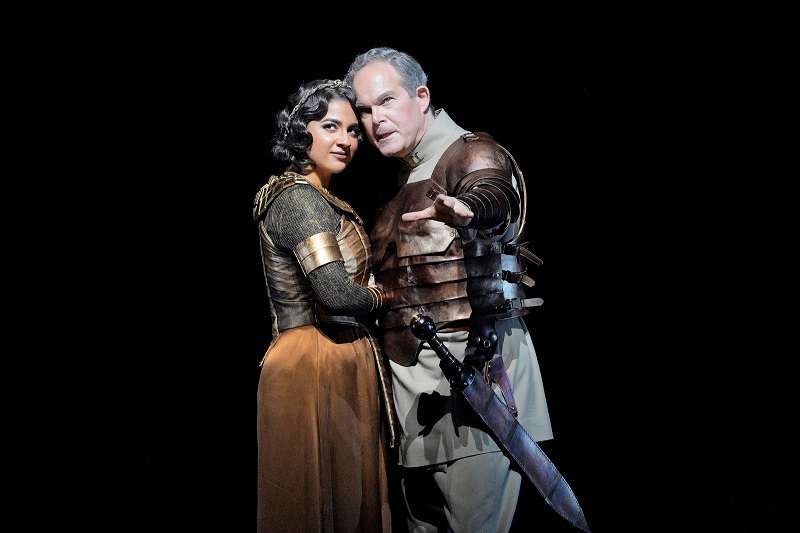
‘ANTONY AND CLEOPATRA’ IN MORE FORMAL, MORE MODERN ATTIRE
Composer John Adams has made a welcome attempt to bring under control the unwieldy “Antony and Cleopatra” story out of Shakespeare. Evolving from there, past composer Samuel Barber’s grand 1966 Met failure, to Adams’ world premiere, it has been boiled down from some 40 scenes and two dozen solo voices (ouch!) to this sleek, late-model version in three hours, two acts debuting Sept. 10 to mark the 100th year of the San Francisco Opera.
If you were waiting for gooey Pucciniesque scenes of the two lovers, this was not your opera. Instead of affairs, Adams focused on affairs of state, plus ensuing conflicts, in a far more formal way.
This is a chess match turned civil war between the ancient Romans Caesar (Augustus) and Antony, with the alluring queen Cleopatra running all over the chess board and resetting all the clocks with impunity. And the punchy, highly rhythmic score festooned with electric outbursts of brass and percussion was all Adams, making no concession to popular expectations (nor any semblance of the silver screen’s Elizabeth Taylor/Richard Burton pairing). His music is at its best conveying scenes of high tension, which the opera provides in abundance. If there was more than the normal quota of opera-house dissonance, how else to portray the would-be hero walking away from two wives, moving in with a minority queen from North Africa, and taking up arms in a power struggle? Historical severity was there on all counts. And Eun Sun Kim’s orchestra was aboard to make it all happen.
Antony hops in and out of so many bedrooms and marriages, with yet more disasters in real combat, you wonder how ancient Rome ever survived anything. Well, civil wars are as good a way as any to start or to bring down the greatest dynasties (here, pitched battles leading to the victorious Caesar becoming the first emperor of the Roman Empire).
The cast turned out much better than expected, given the cancellation (pregnancy) of the original Cleopatra, Julia Bullock. Lyric soprano Amina Edris stepped in smartly with a sterling high range and the look of an Egyptian queen—at least, as close as you might get with this 1930s setting of 2,000-year-old history. We could certainly have done well without those 1930s perms, or films of early Ford touring cars, right, Caesar?
In the early going the Antony of baritone Gerald Finley was the night’s apex sonically and visually. He got strong support from tenor Paul Appleby (Caesar) as the opponent, an emperor outfitted in plain modern business suits that deserved at least a few epaulets. Stage Director Elkhanah Pulitzer and the various designers made it work with minimal tools like sliding panels and a couch or bed, all allowing for rapid scene changes.
Working with a dramaturg but no credited librettist, Adams leaned on cherry-picking scenes and texts out of Shakespeare, plus added snippets from Plutarch and Virgil.
A complete overview will appear subsequently, as I could not remain to the final curtain. Earlier on, the visual highlight was playing out Antony’s disastrous naval battle at Actium, bolstered by the ballast of the robust chorus on stage—a much-needed glimpse of large-scale opera-drama in a work with scarcely any show-piece soliloquies or ensembles.
THE SONIC HALO—If you are attending, the best sonics in the whole Opera House (and lowest prices) are in the nose-bleed section of the top balcony, in Row L, above the last elevator stop. An acoustic-horn effect up there magnifies the sound breathtakingly while enabling patrons to hear the pit orchestra in all its glory. Cognoscenti head up there, dressing lightly, sometimes taking binoculars.
ADAMS NOTES—Previous operas by Berkeleyite Adams, 75, involving historical figures and events, included “Nixon in China,” “The Death of Klinghoffer,” “Dr. Atomic” and “The Girls of the Golden West.” He is widely cited as the leading American composer alive today.
WORLD-PREMIERE OPERA by John Adams, “Antony and Cleopatra,” Sept. 10 to open the S.F. Opera’s 100th year. In English, with supertitles; nine scenes, two acts, just over three hours. Opera House, San Francisco, repeating to Oct. 5. For info: (415) 864-3330, or go online: www.artsSF.com.